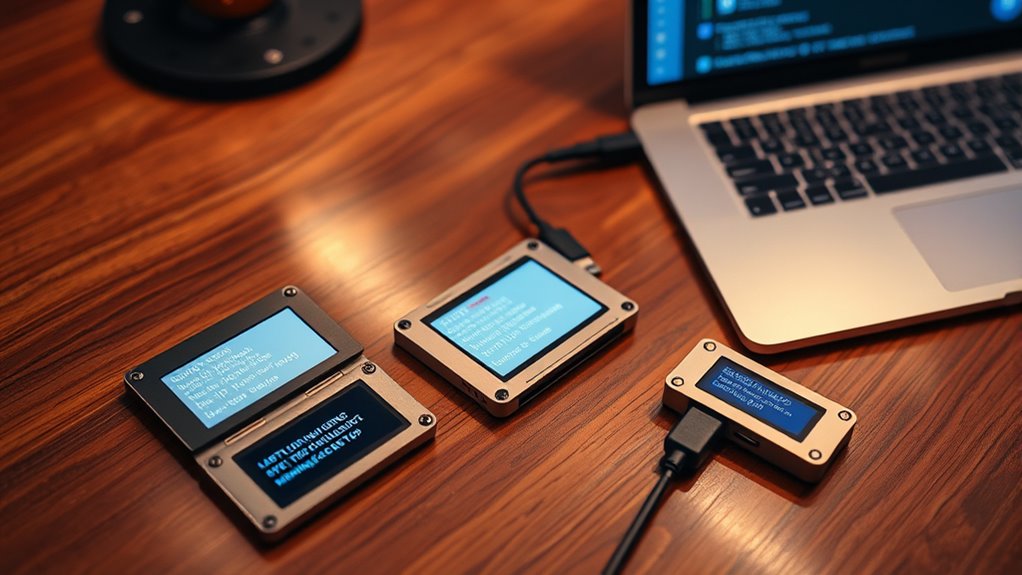To establish a 2-of-3 multisig vault with hardware wallets, first generate unique seed phrases for each device and securely store them separately. Extract public keys from each wallet, then use compatible software like Electrum or Sparrow to create the multisig wallet, configuring it for two signatures. Verify address consistency across devices, test transactions, and assure signing works smoothly. Continuing with this process helps you build a secure and reliable multisignature setup.
Key Takeaways
- Generate unique seed phrases for each hardware wallet and securely store them separately.
- Extract and import public keys (xpubs) into wallet software, configuring a 2-of-3 multisig setup.
- Verify address consistency across hardware wallets and software before testing transactions.
- Conduct test transactions with multiple signatures to ensure proper multisig operation.
- Implement secure backup and recovery plans for seed phrases and private keys to prevent loss.

Setting up a multisig vault enhances your cryptocurrency security by requiring multiple signatures for transactions, reducing the risk of theft or loss. To begin, you need to prepare hardware wallets from at least two different brands. Using diverse brands ensures you benefit from varied security features and minimizes potential vulnerabilities associated with a single manufacturer. Generate unique seed phrases for each hardware wallet; these phrases are vital for securing your private keys. Store each seed phrase in separate, secure locations, ideally hidden and without obvious labels, to prevent unauthorized access or accidental discovery. Before proceeding, make sure all your hardware wallets are fully initialized and ready to use, confirming they function correctly and are set up securely. Implement a personal coding system for your storage containers to discreetly identify their contents, adding an extra layer of security.
Next, determine the configuration that best suits your security needs. A common choice is a 2‑of‑3 setup, where two signatures are required to authorize transactions. Consider your workflow and transaction frequency to balance usability with security—more signatures increase security but can slow down transaction processes. Also, plan for backup options in case one key or device becomes compromised or lost. If multiple stakeholders are involved, clarify their roles and how they will participate in signing transactions, ensuring everyone understands the process. A well-planned setup minimizes operational risks and improves overall security. In addition, understanding how hardware wallets integrate with AI-enabled security features can further reinforce your setup and protect against emerging threats.
Generate keys from each hardware wallet by creating multiple hardware wallets with different brands. Extract the public keys, or xpubs, from each device without exposing private keys. Use wallet software like Electrum or Sparrow to create your multisig wallet. Import the public keys from each hardware wallet into the software and set the number of signatures required for transaction authorization—such as 2 out of 3. Configure your wallet to require multiple signatures, and prepare it for transaction signing. Carefully manage your keys, keeping private keys secure and only sharing public keys as needed. Verify that your hardware wallets are compatible with your chosen software and that the setup process runs smoothly.
Once your multisig setup is configured, verify that wallet addresses match across all devices and the software interface. Confirm that the receive address is consistent and that it requires multiple signatures for spending. Cross-check addresses on each hardware wallet against the software display, looking for any mismatches or errors, which could indicate security issues. Generate a small test transaction to ensure the process works correctly. Sign the transaction with the required number of hardware wallets, then monitor its processing on the blockchain. Troubleshoot any issues that arise during testing to confirm your multisig vault functions reliably and securely. This careful setup guarantees your cryptocurrency holdings are protected by multiple layers of security, making theft or loss considerably more difficult.
Frequently Asked Questions
Can I Add More Signers Later?
You wonder if you can add more signers later. Generally, it’s possible, but it often involves updating the wallet’s configuration and creating a new setup. Keep in mind, you’ll need consensus from existing signers, and some software or hardware limitations might restrict this process. It’s essential to securely manage new keys and guarantee everyone agrees on the changes to maintain the security and integrity of your multisig wallet.
What Happens if One Hardware Wallet Is Lost?
Imagine losing your hardware wallet during a trip. In a 2-of-3 multisig setup, you’re still safe because you only need two keys to access your funds. If one wallet is lost, you can recover it with the seed phrase and use the remaining devices to approve transactions. Just guarantee your seed phrases are securely stored separately, so recovery remains smooth without risking your funds’ security.
Is Multisig Compatible With All Cryptocurrencies?
Multisig isn’t compatible with all cryptocurrencies. You’ll find it works well with UTXO-based coins like Bitcoin and some EVM-compatible chains like Ethereum. However, many other cryptocurrencies lack native multisig support or require custom solutions. You need to check each blockchain’s capabilities, as some rely on smart contracts or other methods. While multisig enhances security, it’s essential to verify compatibility before setting up your wallet.
How Long Does the Setup Process Typically Take?
You might think setting up a multisig wallet takes just a quick hour, but it actually demands more time. Typically, you’ll spend 4 to 9 hours, especially if you’re new or syncing a full node. The process involves preparing hardware wallets, configuring software, securing backups, and testing transactions. Rushing could lead to mistakes, so allocate enough time for careful setup, ensuring your multisig vault is both secure and functional.
Can I Use Different Brands of Hardware Wallets?
You can definitely use different brands of hardware wallets for your multisig setup. Many software platforms support multiple brands like Ledger and Trezor, offering flexibility and enhanced security. Just verify your chosen software wallet is compatible with each device and manages derivation paths correctly. This approach minimizes single points of failure, boosts security diversity, and provides recovery options, making your multisig setup more resilient and customizable.
Conclusion
Setting up a 2-of-3 multisig vault might seem complex at first, but it’s a powerful way to secure your assets. Don’t worry about losing one device—you still have access with the remaining wallets, making your funds safer from theft or hardware failure. Once you get comfortable with the process, you’ll wonder how you ever managed without this added layer of security. Take the leap—your future self will thank you for it.









